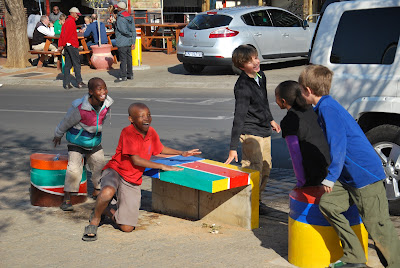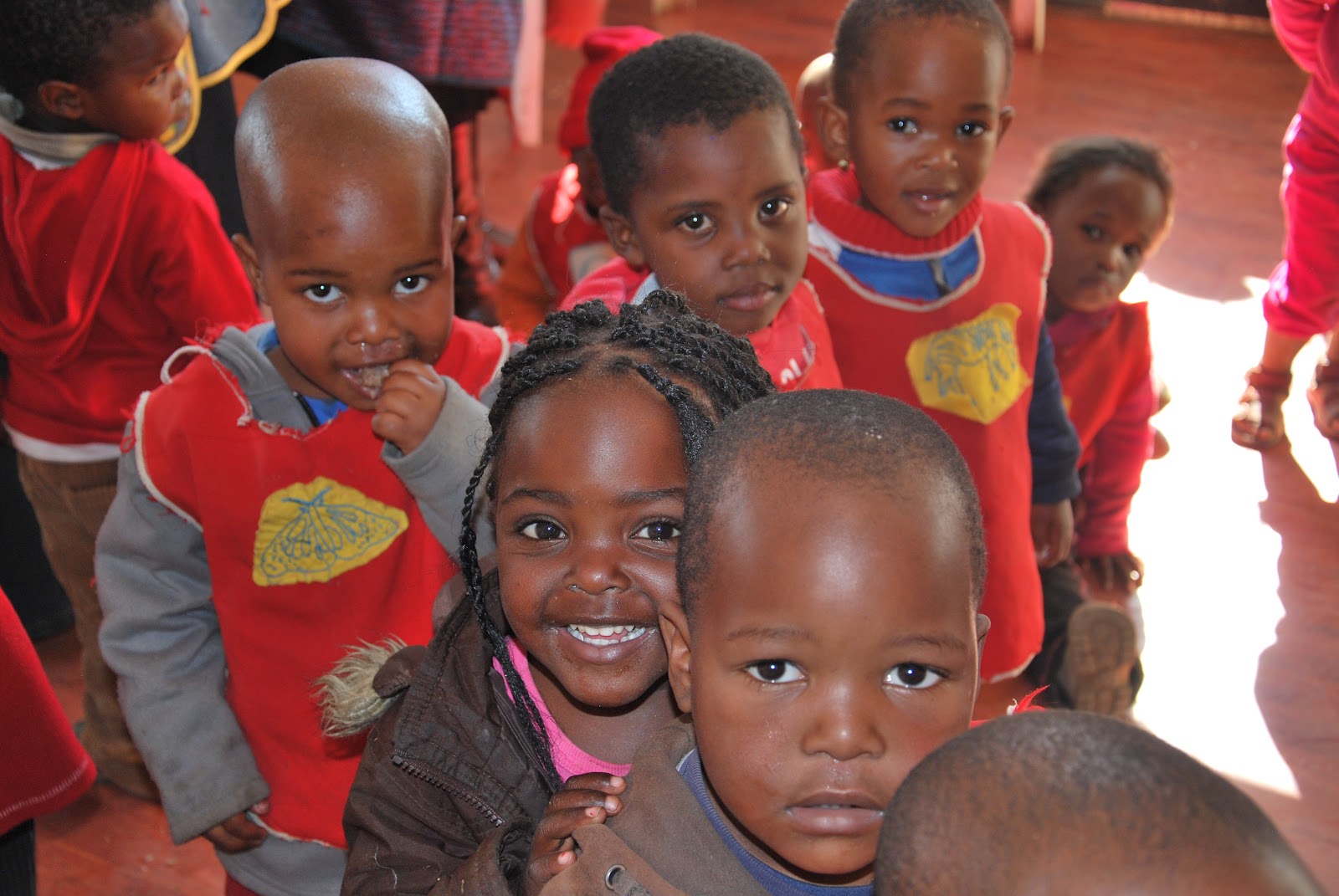Share this post:
on Facebook
on Google+
Soweto South Africa: A History, The Street Life & Some Playtime
“Mayibuye Afrika!”, meaning “Let Africa come back!”, a phrase often shouted in the decades long fight against apartheid, the laws of segregation put in place by the ruling minority of South Africa in the 1948 – which ended just less than 20 years ago, rings in my head as we wander the streets of Soweto, the township in which the freedom struggle was born, with our kids. I’ve just finished reading Nelson Mandela’s autobiography “A Long Walk to Freedom” and am not sure what to expect from this once crime-ridden area of extreme racial tension near Johannesburg, but I am about to find out.
Soweto, which stands for South West Townships was created by the ruling Apartheid government as a place to re-locate black citizens outside of Johannesburg. We are about to head into the center of Soweto with our two children Nathan, 11 and Seamus, 9. Our guide – arranged through
Destination Southern Africa – Lynda is from Soweto and takes us to three areas – the three layers of Soweto. There is the “wealthy” area where blacks were able to own property before Apartheid and then, with major restrictions (like paying rent on your own property), during apartheid. The brick homes look similar to what you find in the USA with walled yards, garages and gardens. He points out that this area is backed by hostels, which is transitional living between the slums and a better life. These government subsidized dormitories don’t have running water – a pump supplies the community as water is considered a human right and thus supplied by the government at pump stations for washing clothes, dishes or themselves outside. There is no electricity. This is slowly being replaced by new housing with modern amenities. Lynda is proud of the progress, but he is quick to tell us that all of Soweto is not like this – the next and lowest layer of the of the onion.
 |
Nathan and Seamus playing with kids
from un-official settlement in Soweto |
 |
| Soweto Township South Africa |
After a stop at the Freedom Monument and a nearby lively street market full of friendly faces selling everything and anything your could need, we meet a friend of Lynda’s who grew up in an unofficial settlement – a shantytown in Soweto called Kliptown – and now works with Kliptown Youth Program. He is about 20 years old and speaks passionately about the importance of education to improve quality of life. He offers to show us this lowest end of Soweto. He leads us through narrow dirt streets which wind through tiny corrugated shacks that look as if they could fall over like a stack of cards. The small, dusty alleyways are full of kids and some of the poorest of Soweto packed into a beehive of interesting Third World real life that our kids get to experience first hand. He points out fences made from old mattress box springs stressing that everything is used again and again – recycling out of need vs environmental purposes. Walls are pieced together with scraps and boxes and wires. Kids with no shoes wander past as they smile huge grins and give us the “thumbs up” sign. The kids find a group of local kids plain with a top and are invited to join in the fun.
 |
Nathan and Seamus playing with kids
at Kliptown school, Soweto |
Finally, our guide leads us to a school – the school he attended as a small child. A few small rooms and a place for naps and lunch, a bowl of rice. His principal, Mrs. Mfaxa, greets us with a huge smile and a warm hug for her former student as our kids instantly make new friends. They share everything they have with them instantly. He tells us that attending this school under her guidance has made all the difference in his life. Mrs. Mfaxa invites us in for a look around and Nathan and Seamus are instantly swarmed by groups of school kids aged 2 – 5. They sing songs for us, play chase with Nathan and Seamus, grin from ear to ear and teach the kids the Zulu thumb handshake.

Though they live each day with nothing – most in a small one-room “house” with walls so thin you can hear neighbors on each side, dirt floors and mats instead of beds, they seem happy. They find joy in a simple top or a can tied to a string. They use their imaginations. They crave to learn and value education, most walking a mile or more to school each day. And according to our new friend that craving does not go away. Education is their hope…their hope for a better life. And it is that hope among the youth of today that is so different than their families from just a few years ago when the youth lived in fear – fear of persecution, fear of arrest and even worse.
 |
| Kids at Pastoral Centre Pre-School and Creche in Kliptown |
We say goodbye to the dozens of smiley faces and singing kids we met in the dusty slums of Soweto’s “un-official settlement” and head to where the student uprisings began just a few decades ago.
 |
Seamus looking at memorial at
Hector Pieterson Museum |
Just down the street from Kilptown, we visit the Hector Pieterson Museum. This museum is on exact the site of the 1976 student uprisings that brought the apartheid struggle to an international level in the media. On June 16, 1976, students, frustrated by a system that offered no hope, staged a peaceful protest. A new government rule, added to an already failing “Bantu” school system (for black South Africans), stated that all classes must be taught in Afrikaans – the language of the Afrikaner minority who controlled the government. The only place in the world that spoke in Afrikaans was South Africa. The students wanted to keep learning English instead of a language foreign to them – a language they said which was that of their oppressor. They marched down the street from their school with signs, singing and chanting, joined by children from other schools. As they neared the end of the street they were met by police who threw tear gas and open-fired into the crowd. Many children were injured and died that day, including 13 year-old Hector Pieterson; a day that brought the struggle to the attention of the world (a picture of a boy carrying Hector’s body and running from the police was published around the world), and started protests in Soweto that would continue for more than a decade.
 |
Danny showing kids bullet holes in
windows from Regina Mundi Church |
During this time students – or any blacks – were forbidden to meet in small groups. The youth of Soweto turned to the sanctuary of Regina Mundi Church. Danny, a local who lived through this turbulent time, points out bullet holes and broken down altars, where police had broken up meetings using mass force. Nathan and Seamus have lots of questions for Danny about what it was like to be in school back then and what happened when the police came to the church to break up the meetings, which he answers perfectly engaging them on their level.
 |
Seamus watching a street performer
with new friends in Soweto |
Nelson Mandela had already been in prison for over a decade when he heard the news of the Soweto Uprising. He weeped for the children, but understood their frustration. Upon release from prison in 1990, Mandela moved back to his house at 8115 Orlando West in Soweto. Also on this street, just a few doors down, is the home of Desmond Tutu, the first black bishop of South Africa and a freedom fighter in his own right; two Nobel Peace Prize winners on one small street! Mandela House is now a museum on a wide street lined with outdoor cafes, shops, street performers and a fun, funky vibe. As we have lunch on a patio, Nathan and Seamus meet local kids and start up a game of tag. Their laughter is heard through the streets – bouncing past the once tension-filled racial relations in this area. With smiles and handshakes – they know nothing of the struggle that happened long before their birth, and it shows.
Although it can be difficult for kids to experience the poverty and the violent struggle of students to obtain today’s freedoms in South Africa, open lanes of communication can help. We constantly talked to them about what they were thinking and how it made them feel and ended up having some in-depth conversations that will remain in my memory forever and furthered our family bond. Meeting happy, new friends and interacting on a child-level – playing, laughing, etc – also helped them join in the hope that resonates in Soweto today.
“Let Africa come back!”…for a new generation filled with hope for a better life it has. Although there is some work to do – to assist the poorer areas, to equalize educational opportunities – progress is being made. And most of all, their exists hope for black, for white, for poor, for young – opportunity is knocking!
 |
| The “Un-Official Settlement” area. Nathan and local guide in the background. |
 |
| Playing Tag with kids in Soweto Township in front of Nelson Mandela’s home |
Share this post:
on Facebook
on Google+

















